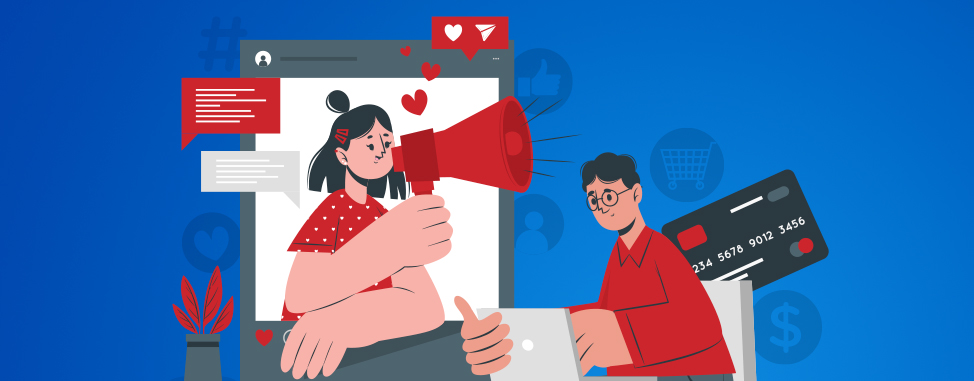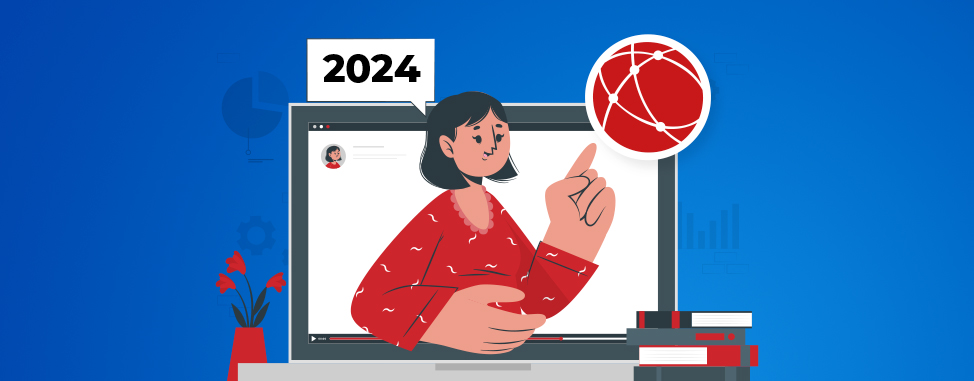
What’s influencer marketing?
It's no longer a secret: the meteoric rise of social networks and the internet is opening up a host of new opportunities for businesses. These include a wide range of marketing strategies, such as influencer marketing.
The term "influencer" is sometimes seen in a negative light. Often, we think of influencers who make headlines or dance on TikTok. Things have changed, however. Today's influencers are increasingly sincere and authentic. They create relevant, quality content, rather than just promote products.
And often, their audience is tuned in and highly engaged! So why not harness this engagement to promote your brand? Here's what you need to know:
- What is influencer marketing?
- The benefits of influencer marketing
- Choosing the right influencer
- Influencer marketing costs
- Is influencer marketing for me?
What is influencer marketing?
Influencer marketing is a marketing strategy based on collaboration between a brand and certain individuals, commonly referred to as "influencers", to promote said brand, product or service. The idea is to use the notoriety and credibility of influencers to reach and persuade their audience. These influencers will promote a product or service, whether through video or in writing, by talking about the product or integrating it into their daily lives.
Unlike other forms of marketing such as affiliate marketing, SEO and content marketing, influencer marketing can illustrate, in a more immediate and convincing way, the impact of a product or service in consumers’ daily lives.
In Canada, influencer marketing has proven to be a particularly effective strategy for many digital campaigns. According to a study by Ressac and Leger, 73% of Canadian internet users who follow influencers have changed their behaviour or made a purchase following exposure to influencer content.
Canadian consumers value recommendations from credible and familiar sources on various social platforms such as Instagram, YouTube and TikTok, giving influencer marketing considerable power.
Types of influencers
We often have this notion of influencers with 500,000 subscribers. But did you know that there are different types of influencers, and that not all of them have hundreds of thousands of subscribers? Here's a short summary of the different types:
Obviously, this is an average, as there are no precise figures to quantify each type of influencer. However, here's an interesting fact: nano-influencers, those with the fewest followers, have the highest engagement rates. They're often the most accessible, too.
The role of brands and agencies
Brands and agencies have key roles to play in an influencer marketing campaign. Brands are responsible for identifying their marketing objectives, defining their target audience and selecting influencers that match their values.
Agencies specialized in influencer marketing will act as a relay between a brand and an influencer. They can find the best influencer for a given campaign. They also negotiate contracts, design campaigns and measure performance.
A partnership between these two entities will certainly result in a more successful campaign.
The benefits of influencer marketing
We're not telling you anything new when we say that influencer marketing has many advantages. Still, here are just a few of them:
Increasing your visibility
For this type of campaign, when you target an influencer who has a large community of followers – or few followers but who are highly engaged – you expose your company to lots of potential customers. Provided you choose the right influencer, of course.
Building brand trust
When choosing an influencer, make sure they are honest and authentic. That way, they'll be talking about your product or service in the way only a fan could. Their community will trust them, and therefore, your brand.
Benefitting from an engaged community
Influencers are seasoned content creators who publish regularly. It's safe to say that their algorithms are constantly primed and ready! Therefore, a publication from them can quickly go viral. Their subscribers will like, comment on and share their publications. This is even truer in the case of nano-influencers, as they are often the closest to their community. They may have fewer subscribers, but their followers are far more active and engaged. So as soon as they share an opinion on a product or service, people will take note.
Maximizing your chances
To reap the benefits of an influencer campaign, it's important to be well-prepared. Above all, that means effectively targeting the campaign's objectives: make sure to choose the right audience and the right influencer to create a close relationship with that audience.
Choosing the right influencer
This step is crucial to the success of a campaign. A wrong choice may result in an unforeseen, negative impact.
High cost
If you don't take the time to accurately target influencers who match your brand and values, you risk spending large sums of money with no return on investment. A very popular influencer may charge you exorbitant rates, but perhaps their subscribers aren't your target audience at all. It's the same with poorly structured, unclear contracts.
Imagine, for example, that you're collaborating with an influencer on a new product. This person creates quality content, which attracts thousands of followers and significant visibility for your product. However, after the campaign, disagreements arise over the rights to use the content, and intellectual property rights have not been clearly established in the contract. You could end up with legal disputes, and therefore substantial legal costs that could have been avoided.
Influencer controversy
Who hasn't read about an influencer controversy? Remember the Sunwing debacle? Influencers often make the headlines, and not always for the right reasons.
If you don't want to end up with controversial partnerships, be cautious and select people who have the same values as you. Otherwise, partnering with an influencer at the center of a controversy could damage your reputation, and consumer trust or, even worse, result in campaign cancellations.
Lack of authenticity
It's often talked about, but it's a crucial point! Did you know that "61% of consumers believe that authenticity is the most important quality an influencer should have"? Lack of authenticity in influencer marketing risks compromising the trust between the influencer and his or her followers.
And it's so important to be authentic, especially these days! The proof? “Authentic” has been named Merriam-Webster's Word of the Year for 2023.
Picture the following scenario: an influencer chooses to promote a poor-quality product that doesn't correspond to their values, or push a dangerous or counterfeit product without even having tested it. What will happen? The campaign will be perceived as a scam by subscribers. And of course, when the influencer promotes their next product, their community will be much more suspicious, even at the risk of not trusting the product in the first place. Imagine being the company behind that next product!
Hence the importance of reaching out to influencers who maintain a high level of credibility and authenticity. This is also why we often recommend giving an influencer almost "carte blanche" in a campaign. They know their audience better than you do, and they'll know how to talk to them. And the more authentic the content, the more likely it is to pay off!
How to reduce the risks associated with influencer marketing?
To ensure a successful campaign while minimizing the inherent risks, we recommend that you select your influencers carefully, ensure they are diverse and, above all, draw up clear agreements with them.
Of course, even with these measures in place, situations may arise that are beyond your control. But if you put all the odds on your side, there's a better chance that the collaboration will pay off for both parties.
Influencer marketing costs
Many factors can influence (!) the costs of influencer marketing:
- The influencer's reputation
- The number of subscribers
- The type of content to be produced (text, video, photo, etc.)
- The desired engagement
- The number of posts etc.
Obviously, all this will be discussed and drawn up in the contract.
To give you an idea of the real cost of an influencer campaign, the Metricool website offers the following rates, based on the number of subscribers:
| A base rate of $10 for 1,000 subscribers |
|---|
| To this standard rates are added:
+ $100 for every 10,000 subscribers |
You can also use the rate calculator offered by Influence Marketing Hub to find out the approximate costs on Instagram, TikTok or YouTube.
Is influencer marketing for me?
Yes, without a shadow of a doubt, companies will benefit from influencer campaigns in 2023. As long as they're done right.
You can also encourage UGC – user-generated content – which is less costly, more authentic and more diverse. This means encouraging consumers to talk about your product via videos, forums and Google reviews.
It's always possible to work with influencer agencies to find the influencer who best suits your needs. But above all, don't forget to plan a social networking strategy to avoid spreading yourself too thin!
Stay tuned for our next article on influencer marketing!

Also on the WHC Blog

2023 in Review + 2024 Sneak Peak
2023 flew by at WHC. Our team rolled up their sleeves and worked hard to improve your experience with Canada’s favorite web host. Let's take a look back at what we did before getting a sneak peek at what's coming your...
Read full article
6 reasons to update WordPress
In the fast-paced world of website management, keeping your WordPress site up-to-date is more than just good practice—it's essential. Doing your WordPress updates regularly means having the peace of mind that...
Read full article





